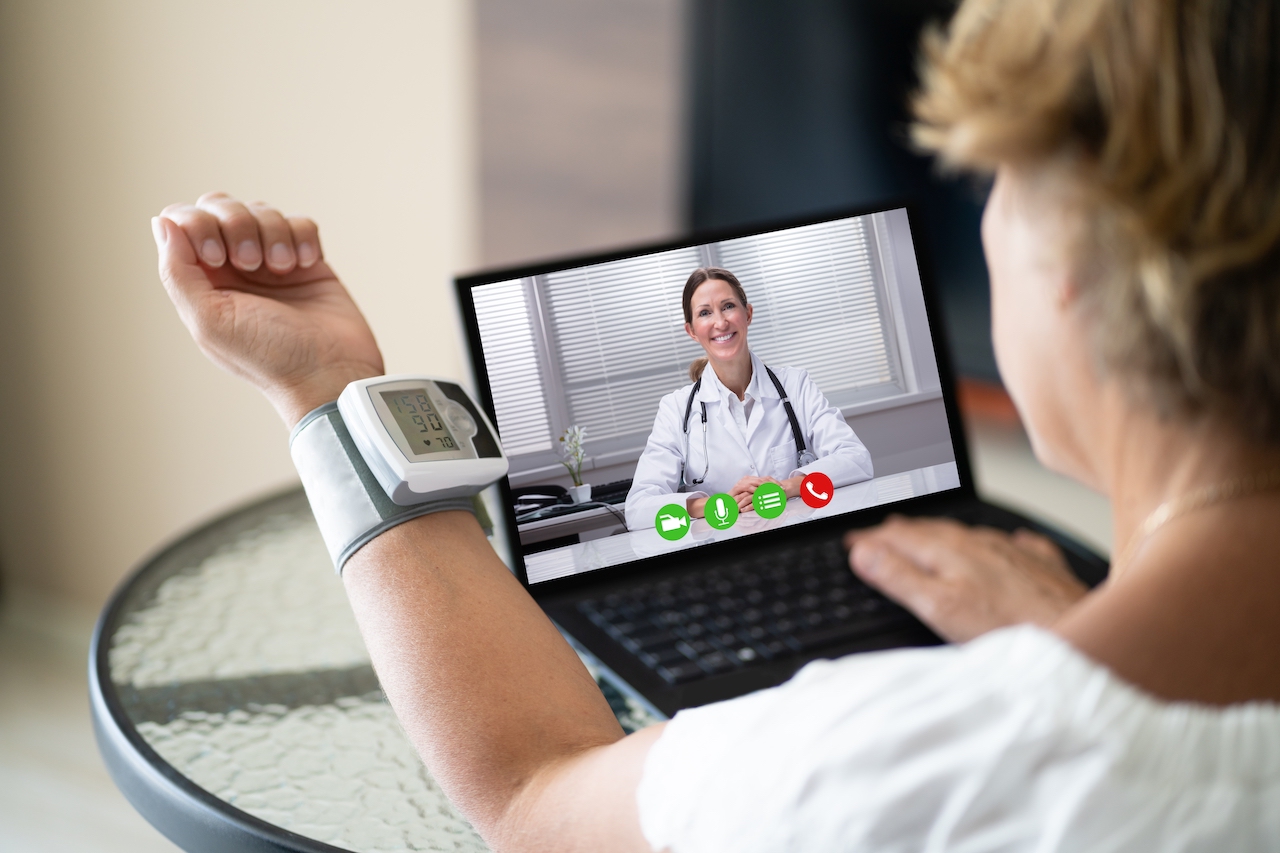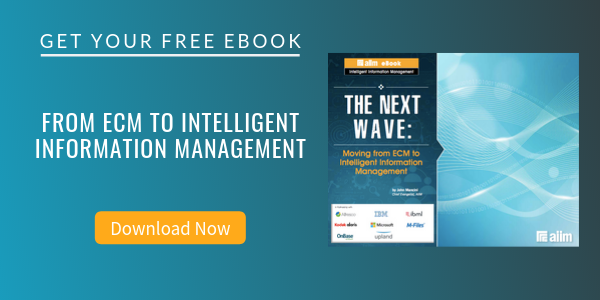
Information Management in the Not-So-Distant Future of Health Care
Healthcare | Intelligent Information Management (IIM)
I’m at that age when the body starts to go. I now see 100 doctors – no, really, 85 at least. Or so it seems. If I’m not Zooming with my primary care provider, I’m swapping data with a specialist via a phone app or transmitting my blood pressure readings from my remote monitor to the disembodied nurse in my voicemail who chides me with messages if I miss a reading.
Most of the admin and much of the care is now on me. Except for my prescriptions, which parachute into my front yard from the belly of a drone whose pilot and bombardier are an AI system.
Hospitals are slowly going “transvirtual,” too. Everything but big tech, like MRI equipment, and critical or very specialized care gradually will be “constructively cannibalized,” so it’s more often outbound, home-based, and virtually augmented. Doctors and nurses waste about 25% of their time on admin, which absents them from caring for patients (“Breaking the Cost Curve,” Deloitte). Virtual self-care aims to cure that.
In the future, “prosthesis” will take on a whole new meaning. Your body will be “functionality-plus” -- augmented by wearables, sensors, and implants that output data streams so your doctors can see how well or ill you are. Your real body, therefore, will propagate a data double as unique as your fingerprint and managed by medtech. Your symptoms will often be diagnosable from that data. Your data double will be a pattern, not you.
As health care digitally transforms, more care will come via webs of smart virtual processes that warp and weave, engaging with your data and delivering insights about treatment. If this sounds abstract and scifi, not to worry. Digital care is getting affordable and convenient as well as preventative, personalized, precise – and sometimes even cool.
That’s the plan anyway.
The Outmoded As Is
That’s a vision of where we are heading, not where we are.
If you get real sick now, the economic reality of health care, at least in America, can be pretty grim. We have the best health care in the world – and it’s killing us.
Americans spend $5,220 a day for hospital stays. Two-thirds of personal US bankruptcies are due to medical debt. Each year, millions of people are pushed into poverty by out-of-pocket health expenses (Stacker.com – “15 Facts About Medical Debt”). This is particularly true for the elderly. People are living longer now, so they need more serious care for more years.
As the pandemic showed us, caregivers on the front lines of health care somehow get it done. Doing the most for the most is their charge; their challenge is navigating legacy health care environments that are fragmented, complex, and non-standard because they’re comprised of payers, product makers, care providers, policymakers, and patients, all of whom have different incentives to best operate.
The classic example is the insurer that won’t pay for care that a doctor determines a patient needs. Insurers are about profit; doctors are about delivering the best care. The two sometimes operate at cross purposes.
Telemedicine
Today, if you have a computer, you have a doctor – videoconference doctor visits routinely complement in-person ones. Doctors are digitally monitoring and maintaining health, so they can physically intervene early on if there’s a problem. Early intervention and “care by exception” cut down on costly in-person medical visits.
Due to the pandemic, in 2020, US telemedicine visits exploded by 683% (US Department of Health and Human Resources). By 2028, the global telemedicine market will be almost $299 billion (“Telemedicine Market Size Worth $298.9 Billion By 2028,” Grand View Research).
Use cases for telemedicine are legion. With collaborative videoconferencing:
- Low-income patients without insurance can use the Emergency Room less often. The cost savings are significant as a telemedicine visit costs about $50 versus $2,200 for an ER visit without insurance (“How much does an ER Visit Cost Without Insurance in 2021,” Talktomira.com).
- Geriatric patients who are less mobile can more easily visit doctors, and doctors can remotely manage their chronic conditions such as cancer, heart disease, stroke, and dementia.
- Physical therapists can use digital simulations to remotely model movements for patients at home who must practice them after an injury or surgery.
Once exposed to telemedicine, patients expect it. It enables convenient teleconsults and gives caregivers real-time data for better decision-making.
Telemedicine is one mode of a “value-based” approach to health care that now complements the traditional “fee-for-service” one. The first stresses proactive, preventative care that’s less costly over the long run; the second delivers more costly reactive and episodic care when a patient gets sick.
mHealth
There are over 350,000 mHealth apps for US consumers (Mobius.md). The global market will hit $362 billion by 2027 (Emergen Research). mHealth apps are digital, smart, and data-intensive medical and fitness apps you can access via wearables or phone that generally improve convenience or monitor health and fitness.
They range from apps for paying bills, scheduling appointments, and getting prescriptions to those that manage diabetes, intervene for addiction, and monitor hypertension, to ones that measure your heartbeat while you work out.
A typical solution might be comprised of a wearable monitor that transmits blood glucose level data from Type 1 diabetic patients to an app that visualizes the data and sends it to a doctor’s tablet accurately, continuously, in real-time, and in user-friendly form.
Electronic Health Record
Almost all hospitals have adopted the Electronic Health Record (EHR). From one interface, doctors have a summary of the patient’s caregivers, medicines, allergies, medical history, and so on. This solves the problem of dispersed, redundant, incomplete, or inaccurate information common to legacy practice management systems.
With a laptop or tablet, doctors use EHR software to collect patient data generated virtually or in-person from check-in to check-out for each visit and across previous visits. Doctors can add text and dictate notes into the EHR, then analyze, share it, and perform more efficient paperless processes like submitting e-prescriptions.
Predictive Analytics
Data glut and data chaos can be a bane or blessing for caregivers. If data is managed on paper, of course, it’s a bane -- inefficient, redundant, often inaccurate, and always time-consuming. Data on paper manages you.
If managed digitally, it’s a blessing -- caregivers can use AI to train on ever bigger data sets for faster, better insights. You manage your data if it’s digital. Predictive analytics analyzes big data so doctors can intervene earlier for better patient outcomes and lower costs.
In particular, it can predict:
- The onset of sepsis, a common problem in hospitals, by analyzing EHR data and intervening early to prevent it.
- How likely patients will develop conditions like diabetes, cardiac illness, or stroke by analyzing historic EHR data.
- Disease progression for diseases that develop quickly and comorbidities when multiple diseases occur simultaneously, so doctors can ascertain, for example, which diabetes patients will develop renal disease.
- Which patients will keep appointments, take their medicine, etc. Missed appointments mean doctors lose revenue and poor medicine routines undercut care.
- Which resources should be acquired when and allocated where, based on seasonal needs and patient overstays.
- Operations of a hospital’s complex supply chains, so management can cut costs and achieve efficiencies, for example, by streamlining purchases and consolidating vendors.
- Which doctors will best fit patients’ needs, for example, by identifying ones who specialize in certain fields or have weekend or evening hours.
Natural Language Processing and Machine Learning
Hundreds of exabytes of health care data proliferate daily, but most is unstructured -- derived from disparate sources like lab and clinical reports and EHR text and voice notes. Natural Language Processing (NLP) converts unstructured input into structured data in a machine-readable format, so Business Intelligence tools can quickly analyze it. NLP extracts and visualizes only the most relevant data, so doctors can quickly review it instead of foraging in-depth through copious paper or even digital charts.
Much of the data in EHRs is dense images like X-Rays and ultrasounds, so hospitals are also using Machine Learning to automatically annotate images that describe and show, say, tumors or bone fractures. Vendors offer these tools as SaaS services that are affordable and maintenance-free.
Integrated Platforms
Providing the best patient-centric care is now a key competitive differentiator for caregivers. Patients have a greater choice among caregivers, so hospitals and physicians are forced to behave like agile, market-driven, private companies to remain competitive. They, therefore, must adopt better tech over broader, integrated infrastructure to deliver more value to patients and lower costs for caregivers.
The most competitive hospitals are evolving robust, seamlessly integrated, and cloud-enabled platforms that can accommodate more information in all forms, like text and images, so that caregivers can access it from different sources. With hyperscale clouds, hospitals can dynamically manage data and compute resources in a health care ecosystem for faster dispatch and greater flexibility and scalability. These capabilities are critical now in the pandemic when surges of the infected can strain hospitals to the limit.
A private doctor in a cloud-enabled hospital ecosystem can now access X-rays and PDFs of related reports from a radiology clinic and then share them with specialists and patients -- and patients can access them anytime just as they would online bank statements.
Robotic process automation (RPA) is a key enabling technology here because it expedites access to otherwise siloed data by integrating legacy apps with newer differentiating ones across health care ecosystems.
Information Security
Health care, of course, is heavily regulated. To comply with HIPAA, an ecosystem must ensure the confidentiality, integrity, and availability of all patient data. As technology rapidly changes and health care ecosystems expand and get more complex, security must keep up. Security is not a one-and-done exercise, though. Caregivers must pursue an ongoing process of securing their infrastructure to prevent new breaches.
Hospital ecosystems are well-served by Managed Security Service Providers (MSSPs) as they can provide the layered and deep security that expansive multi-dimensional infrastructure requires, and that frees IT to focus on differentiating services to keep a hospital competitive. MSSPs are great for individual doctors without IT departments, too, as doctors get hands-off, top-flight solutions for affordable subscription fees.
The Internet of Medical Things
The Internet of Medical Things (IoMT) is a fabric of wearables and monitors integrated with hardware and apps that generates health care data. Using the IoMT, doctors can monitor physical ailments and treat medical conditions by accessing and analyzing data from the IoMT. For instance, devices like smart belts for the elderly remotely signal caregivers if a person falls, and neuromodulation wearables tap into sensory regions to relieve chronic pain.
Because they’re complex and heavily regulated, IoMT deployments require more security than, say, the Internet of Things. For instance, hackers could steal a patient’s financial data and, in the process, also disrupt the delivery of data from a device critical to his care. About 70% of health care organizations now use IoMT; last year’s IoMT market approached $137 billion (“Internet-of-Medical Things Market Insights,” Allied Market Research).
To Be Or What To Be?
Health care spending in the US alone will total between $8.3 and $11.3 trillion by 2040, but people will invest mostly in devices and practices promoting health and wellness, not doctor visits. (“Breaking the Cost Curve,” Deloitte). Monitoring will come in many forms -- for instance, eshirts measure multiple physiological functions like breathing for COPD patients that are transmitted via blue tooth to a smartwatch then sent for analysis to appropriate medical professionals for their insights into treatment.
Physicians, too, will upgrade to stay competitive. With Virtual Reality, surgeons already practice operations in a safe, controlled, metaverse-like space with no risk to patients. With Augmented Reality, they can more precisely operate via an AR microscope in their surgical devices that digitally overlays and enhances the real area they’re operating on.
Novel microdevices and implants constitute the medical microverse. A microdevice can now store and precisely deliver cancer-killing medicine to tumors, so they don’t biodistribute and kill healthy cells in the process. This leaves patients having fewer debilitating side effects. Implants include deep brain stimulators that electrically regulate abnormal nerve impulses as in epilepsy via electrodes implanted in relevant areas of the brain – so patients don’t have seizures.
All of this begs the question: In the Mediverse, what is a document? X-Rays in an EHR? VR videos of an operation? Readouts from an implant?
One thing we can say for certain is that better data equals better health. Recent research even promises what might be called “bionic betterment” -- there’s now even an AI eyeball that can see more human than human. Sight-as-a-Service? Sounds fanciful, doesn’t it? If I go blind, though, I want one of those. Wouldn’t you?
About John Harney
John Harney is President of SaaSWatch, a SaaS consultancy and IT journalism service where he helps SaaS providers define target markets, ensure barriers to entry, develop cost models, partner for complementary technology, refine use cases and scale fast. He also promotes them by creating materials for websites and editorial for placement in appropriate print and electronic venues. He also reports on SaaS business strategies, technology and use cases in a number of venues. John is a 30-year veteran IT reporter and now covers IT issues across all markets. He is particularly focused on technologies related to Cloud, SaaS, AI and Content Services. He authored one of the first books on cloud computing, has run three magazines focused on content services and has been a KM columnist for Knowledge Management magazine and a SaaS columnist for eDoc, AIIM’s former magazine, which in the magazine’s previous incarnation he ran in the mid-90s. John graduated Phi Beta Kappa in English Literature from Randolph-Macon College, went on to do graduate work in Literature and Writing at the University of Virginia then graduated from Columbia University with an MFA in Writing. Later he earned a degree in Corporate Training from Georgetown University. He is especially interested in IT and its applications that drive the greening of the planet. Before becoming involved in IT, John was an adjunct professor and corporate trainer. You can reach him at 240.877.5019 and jharney583@gmail.com.



